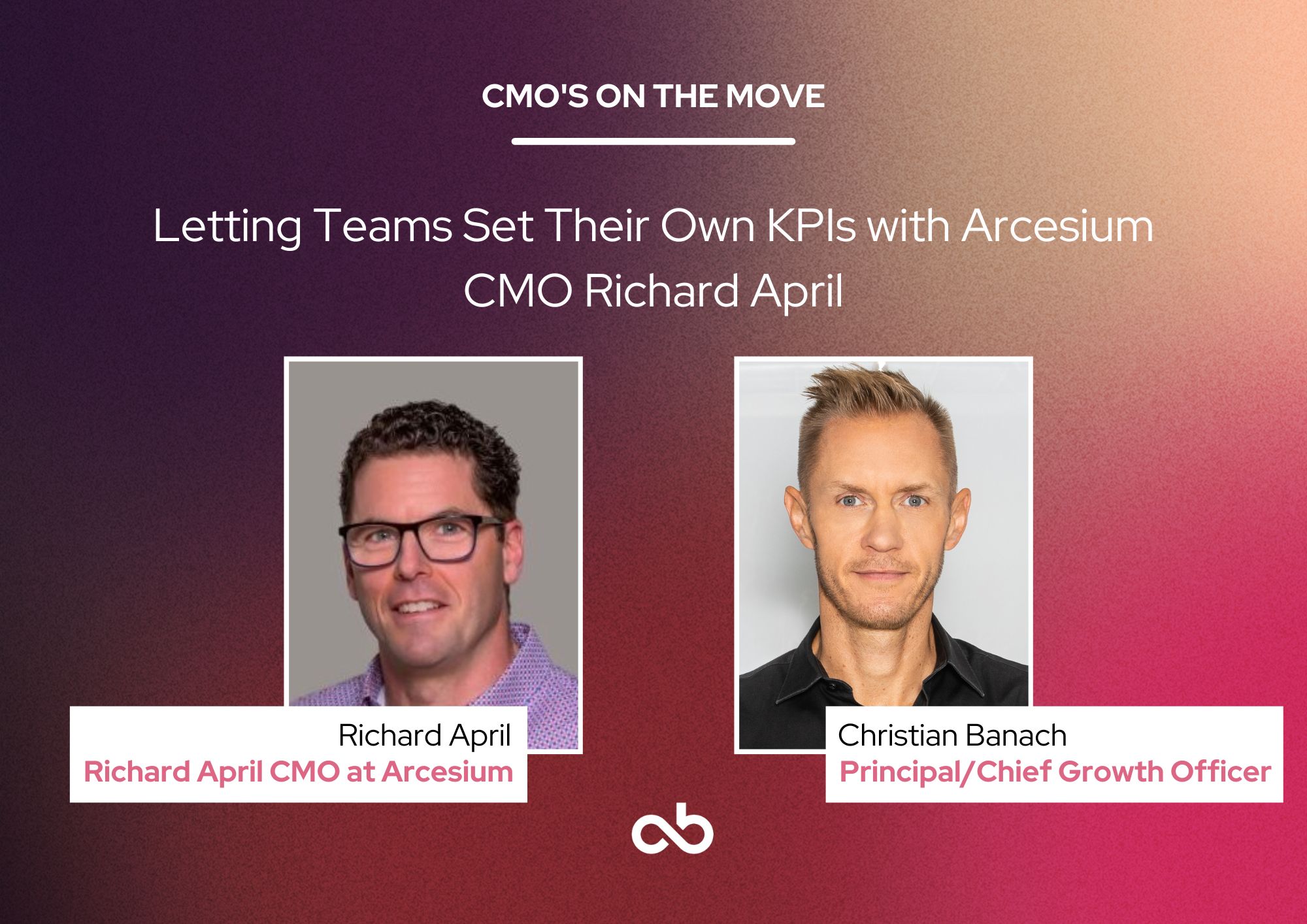CMO Interviews
Letting Teams Set Their Own KPIs with Arcesium CMO Richard April



Arcesium recently tapped marketing and tech veteran Richard April for CMO. Arcesium is an advanced data, operations, and analytics platform used by some of the world’s most sophisticated financial institutions. Prior to Arcesium, April served in marketing roles at software and tech companies like Onshape, Rave Mobile Safety, and Repsly.
Christian sat down with April to discuss his experiences with agency partners and his vision for building Arcesium’s marketing profile.
Where to find Richard April: LinkedIn
Where to find Christian Banach: LinkedIn
Banach:
Tell me a little about how you found yourself in the CMO seat.
April:
At a certain point, I decided, “I want to lead; that’s something I want to do.” And part of that is managing people—I think that’s an underestimated part of the job: managing emerging talent, managing senior talent, and identifying good talent.
There are lots of tools, but it’s really about your team and finding the right people for the right roles. Over the last decade, I’ve realized that the team you build is going to have the biggest impact on your success. That seems obvious, but many people still seem to miss it.
Banach:
Let’s talk a little bit about Arcesium, where you’ve taken over as CMO. Tell me more about what they do.

April:
Arcesium is a global financial technology company, and we deliver pre- and post investmentand enterprise data management solutions for financial institutions—primarily hedge funds, banks, institutional asset management, and private equity. We’ve developed a cloud-native solution that helps systematize the complex workloads and achieve the scale they are looking for.
What is particularly interesting to me is that they have great product depth; they are much further along than they “should be,” in the way the company has evolved. Building a marketing team for something that is already a growing concern, as opposed to a “wish and a dream” has been really exciting.
Banach:
What have been your first goals? As you come in, what does your day-to-day look like?
April:
We’re building out the product marketing function, starting with buyer persona and buyer journey research. We’re looking to build a substantial content marketing function. From there, we’re building out a demand generation function and a corporate marketing function, and improving our web presence, so our approach is more cohesive.
We’re going to take an ABX (account-based experience) approach because we have larger enterprise customers, and we know who they are. We feel that a targeted approach across all facets will be the best route to market. We’re still in the early stages of building that engine.
Banach:
What does the team look like today? What is your vision for a year for now?
April:
Now, a small handful of people, but we’re looking to build out a product marketing team, demand generation team, corporate marketing team and web/UX team
We’re looking to leverage outside firms to fill the gaps with capabilities we don’t have in-house. But as we learn how our customers buy, we’ll adjust—I’m looking to be agile and ready to change as things evolve.
Banach:
That’s a great approach—you start with your best guess based on your expertise and research, but it’s always an experiment. Constantly reiterating and building.
April:
With everything we build, we want to test what we’re doing—even things that we don’t necessarily think will work, we want to test them to make sure we are not overlooking any approach. I think flexibility is key, and I want to avoid preconceived notions about strategy or structure.
Banach:
Tell me a little about KPIs that you’ve been given, or what kind of KPIs you’re setting for your team.
April:
The company has growth goals—they’d like to see marketing contribute to that growth. Some of what we’re doing is demonstrating how marketing is contributing to both pipeline and revenue. We have some overall goals that will filter down to make sure they are all salient to our goals.
I generally like to let the team choose their own KPIs because I think they buy into them more. Let your team lead and coach them through it, and you’ll get more buy in from them in the long run.
Banach:
Besides building the team, what other kinds of challenges are you walking into—what’s keeping you up at night?
April:
Subtle things like explaining the investment that is required in leadership certainly require delicacy and the right approach. Some of that is understanding how they make decisions and which data matters to them.
It’s very tempting to dive into tactical things to solve immediate problems, but those tactical things can be counterproductive for your long-term strategic goals.
Being patient and asking for patience from teams is important. And that’s something you have to convince yourself of as you are building something new too. Managing even your own expectations takes discipline.
Banach:
That’s interesting—people often talk about getting “quick wins” as you step into a new position, but obviously we don’t want to do that at the expense of long term goals. How about agency partners—who are you looking to work with as you build the team?
April:
Outside collaborators will be part of this build, for sure. I won’t be able to hire in-house quickly enough, and there are some skill sets for which you would benefit more from an agency. SEO, for example, can be hard to find someone with real expertise, and you can lean on agencies for that.
There’s also the technical staff—there are large projects that would otherwise require staffing up, like “rebuilding your website,” and it makes more sense to have a partner to do that.
Banach:
As you settle into the role, who have been your best collaborators so far?
April:
Partnering with leadership on the sales side has been one of the most important relationships I can have. Marketing is a service organization for the sales team: if they aren’t successful, we can’t be successful.
Having a good relationship with finance leadership is great too. Demonstrating that the investment you’re making provides results and showing that you’re fiscally responsible helps with future budgeting and shows your marketing’s value to leadership.
Banach:
I like that idea of “market the marketing.” You mentioned earlier the breadth of great MarTech tools out there. How do you evaluate what tools you are using in your suite? How do you balance what’s new and shiny against what you really need?
April:
Carefully.
Banach:
Ha!
April:
I’ve spent a lot of time evaluating MarTech tools over the years. I saw the early moments of marketing automation and the rise of social media. I was knee deep in deploying those systems at that time and it gave me great insight into the power of those tools. It also gave me the perspective of what can happen when those tools aren’t well-integrated or working together.
For me, every piece you choose must be evaluated for how well it integrates. Avoiding redundant feature sets and making purchases as you are going to use it and deploy it.
This also prevents overwhelming your team with new tools, many of which they may be very excited by. But it’s important to have a plan before you deploy it.
Edited for Clarity. Banach and April discussed more about April’s time at McGill, the complexities of marketing technologically sophisticated products, and some of April’s best collaborative experiences.
 Back
Back
Sign up now! Every Monday, get breaking news of recent CMO appointments, motivation to start your week positively, and innovative business development insights.